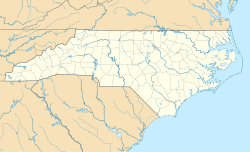
Kill Devil Hills is a town in Dare County, North Carolina, United States. The population was 7,633 at the 2020 census. It is the most populous settlement in both Dare County and on the Outer Banks of North Carolina. The Kill Devil Hills micropolitan statistical area, consisting of all of Dare County, is part of the larger Virginia Beach–Chesapeake combined statistical area.

Nags Head is a town in Dare County, North Carolina, United States. It is a busy vacation spot because of its beaches and sand dunes of Jockey's Ridge. The population was 3,146 at the 2020 census.
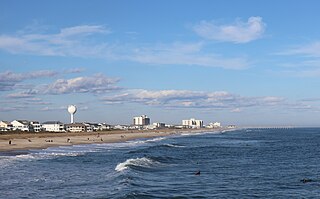
Wrightsville Beach is a town in New Hanover County, North Carolina, United States. Wrightsville Beach is just east of Wilmington and is part of the Wilmington Metropolitan Statistical Area. The population was 2,477 at the 2010 census. The town consists of a 4-mile (6 km) long beach island, an interior island called Harbor Island, and pockets of commercial property on the mainland. It served as a filming location of Dawson's Creek.

Duck is a town in Dare County, North Carolina, United States. As of the 2020 census, the population was 746. Duck is the northernmost incorporated town in Dare County and the Outer Banks' newest town, incorporated on May 1, 2002. Duck offers visitors outdoor recreational activities, summer events and concerts, watersports, fine dining, shopping, art galleries, and a nationally known jazz festival, as well as the 11-acre (4.5 ha) Town Park and soundside boardwalk.

George Franklin Barber was an American architect known for the house designs he marketed worldwide through mail-order catalogs. Barber was one of the most successful residential architects of the late Victorian period in the United States, and his plans were used for houses in all 50 U.S. states, and in nations as far away as Japan and the Philippines. Over four dozen Barber houses are individually listed on the National Register of Historic Places, and several dozen more are listed as part of historic districts.

The Alice Freeman Palmer Memorial Institute, better known as Palmer Memorial Institute, was a school for upper-class African Americans. It was founded in 1902 by Dr. Charlotte Hawkins Brown at Sedalia, North Carolina near Greensboro. The institute was named after Alice Freeman Palmer, former president of Wellesley College and benefactor of Dr. Brown.
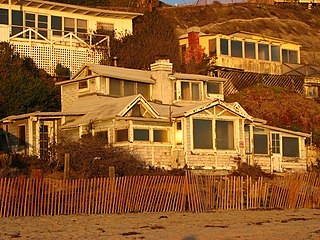
The Crystal Cove Historic District is a part of the Crystal Cove State Park located in Newport Beach, California. It is listed on the National Register of Historic Places encompassing 12.3 acres (50,000 m2) along the Southern California coast. It was listed on the National Register not only because of its significance but also because of the 46 cottages located there which were built in the 1920s and 1930s. These cottages are perfect examples of Southern California coastal development in the early 20th century and were preserved by the Crystal Cove Conservancy Alliance. Since the restoration, the cottages have been open to the public for overnight stays.

Beaufort Historic District is a historic district in Beaufort, South Carolina. It was listed on the National Register of Historic Places in 1969, and was declared a National Historic Landmark in 1973.

The shingle style is an American architectural style made popular by the rise of the New England school of architecture, which eschewed the highly ornamented patterns of the Eastlake style in Queen Anne architecture. In the shingle style, English influence was combined with the renewed interest in Colonial American architecture which followed the 1876 celebration of the Centennial. The plain, shingled surfaces of colonial buildings were adopted, and their massing emulated.

The High Hampton Inn Historic District is a historic estate, resort, and national historic district nestled in the mountains of western North Carolina, in the Cashiers Valley in Jackson County, North Carolina. Originally the summer home of the prosperous Hampton family of South Carolina, the property was listed on the National Register of Historic Places in 1991.

This list includes properties and districts listed on the National Register of Historic Places in Brunswick County, North Carolina. Click the "Map of all coordinates" link to the right to view an online map of all properties and districts with latitude and longitude coordinates in the table below.

West Meadow Beach Historic District is a peninsula of public parkland approximately 1.5 miles long and a former national historic district located in northwestern Stony Brook in Suffolk County, New York. The district through much of the 20th century contained 120 summer cottages built along West Meadow Beach on Long Island Sound. Most were constructed during the 1920s and 1930s, under deeds provided as political favors.
Benton & Benton was an architectural partnership in eastern North Carolina of brothers Charles C. Benton Sr. and Frank W. Benton. Several of its works are listed on the U.S. National Register of Historic Places. Charles C. Benton Jr. and others also worked for the firm.

Richard Sharp Smith was an English-born American architect, noted for his association with George W. Vanderbilt's Biltmore Estate and Asheville, North Carolina. Smith worked for some of America's important architectural firms of the late 19th century—Richard Morris Hunt, Bradford Lee Gilbert, and Reid & Reid—before establishing his practice in Asheville. His most significant body of work is in Asheville and Western North Carolina, including dozens of buildings that are listed on the National Register of Historic Places or are contributing structures to National Register Historic Districts.
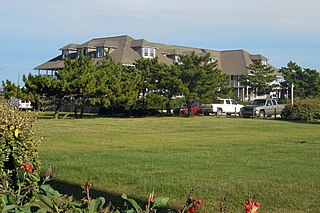
The First Colony Inn, also known as LeRoy's Seaside Inn, First Colony Motor Inn, First Colony Apartments, and Colony Beach Inn, is a historic hotel building located at Nags Head, Dare County, North Carolina. It was designed by Willis Leigh and built by Frank Benton It first opened in 1932 as LeRoy's Seaside Inn, by Henry LeRoy of Elizabeth City, North Carolina. The inn is a 2+1⁄2-story, balloon-frame building in the vernacular Shingle Style. The building is divided into three equal sections separated by open breezeways and arranged in an H-shaped configuration. Surrounding the building is a two-story engaged verandah.
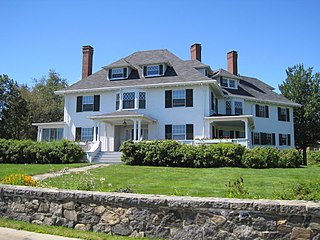
The Little Boar's Head Historic District encompasses an area of summer resort and beachfront properties in North Hampton, New Hampshire. Located on New Hampshire's seacoast roughly between North Hampton State Beach and Bass Beach, the district is almost entirely residential, consisting mainly of houses built as summer vacation spots in the late 19th and early 20th centuries, with associated beachfront amenities. The district was listed on the National Register of Historic Places in 1999.

Markham-Albertson-Stinson Cottage, also known as Stinson's Ranch, was a historic home located at Nags Head, Dare County, North Carolina. It was built about 1916, and was a 1+1⁄2-story, frame, Outer Banks cottage on pilings above the water. It had a wide porch on three sides. It was destroyed by Hurricane Irene in 2011.

Mattie Midgett Store and House, also known as Nellie Myrtle Pridgen's Beachcomber Museum, is a historic home and general store located at Nags Head, Dare County, North Carolina. The store was built in 1914, and the house in 1933. The store is a two-story frame Outer Banks Shingle Style building with a hipped shingle roof. A one-story, hipped-roof, one-room addition was built in 1944. The store was moved to its present site in 1932. The house is a two-story, T -shaped, single-pile frame dwelling with steeply pitched gable roofs.

James D. and Frances Sprunt Cottage is a historic beach cottage located at Wrightsville Beach, New Hanover County, North Carolina. It was built in 1937, and is an elevated two-story, three-bay frame cottage. It features a gable-front roof with exposed rafter tails, a main-level porch with an upper deck, and a double-tier wraparound porch. The ground level includes a two-car garage.

